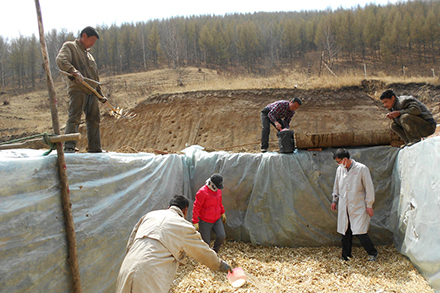Poor weather and geographical conditions plague the fifth village of China’s Yan’gebo township. Yan’gebo is part of Weichang County, Chengde City, in Hebei Province. Most of the villagers commute to large cities seeking jobs as migrant workers to support their families. Xu Li tried to support his wife and child through agriculture in Yan’gebo, but the terrain just wasn’t conducive to growing enough quality crops to make a living. He ended up work in a printing factory in another city and as a driver for many years just to send money home to his family.
In 2011, Xu Li heard about a project in Yan’gebo that was helping farmers develop cattle-raising skills. Through this project, Heifer China teaches villagers new ways to raise cattle. These technologies are based on science and farmers all over the world have found them to be successful. Intrigued and hopeful that this project would bring him home to stay, he signed up.
A year later, Xu Li took the lead on a project to help raise money to construct temperature-constant sheds for livestock. After the sheds were constructed, he purchased more than 10 heads of cattle. He became a major part of his village’s self-help group (SHG), actively participating in every farming technology training. He became so interested in raising cattle that he talked to Heifer staff about the possibility of learning even more technology on a well-known local cattle farm.

In November 2012, Xu Li spent three days at the cattle feedlot in Qipanshan, completely immersed in cattle breeding technology. While there, he learned about cattle and forage selection, forage ratio, feeding and slaughter methods. He quickly saw the importance of following scientific steps to breed cattle.
You can help farmers like Xu Li live more sustainable lives.
In 2013, Xu Li’s peers elected him leader of their SHG. As leader, he continued to share everything he learned about cattle breeding science and technology to benefit his fellow group members. When a cattle disease broke out in 2013, Xu Li’s extensive knowledge about epidemic prevention and careful animal management spared his SHG from cattle loss.
When Heifer China staff visited Xu Li in 2014, they saw a successful farm that seems to keep improving. “A few days ago I sold eight fattening cattle,” he said happily. “I earned more than 60,000 yuan (about $9,772) and I bought 22 calves with the money. Now I have 67 cattle at home. Thirty-seven of them are cows and 30 are fattening calves.”
Xu Li also showed the project staff the microbial silage that was made in the spring. The silage consists of a combination of crops, including maize, sorghum and cereals. It is stored in high-moisture fodder and fed to the cattle. Xu Li offered a handful of microbial silage to the staff, saying, “It smells good and it seems to be successful.” In the future, he plans to build insulation pens that measure 4,305 square feet and a silage pit that measures 1,291 square feet, which he will fill with corn silage. This will help expand his farm’s scale.
“Breeding cattle at home can make me money and help me take care of my family,” Xu Li excitedly explained. Heifer doesn’t focus on providing families like Xu Li’s with just animals. Instead, they provide a wide variety of trainings to teach project participants how to “fish” instead of just waiting for the fish to be given to them. In this spirit and through technology-based practices, more and more people like Xu Li are living sustainable lives free from poverty.
Story and photos courtesy of Guo Na, Project Partner
Heifer China